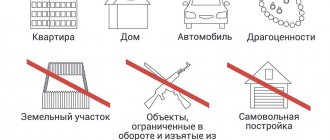As Article 115 of the Code of Criminal Procedure establishes, in order to secure a claim or the alleged confiscation of valuables, the investigator must seize the property of the suspect/accused or persons responsible for their actions, as well as entities who have items obtained illegally. If necessary, an inventory of property is carried out by a bailiff.
Concealment, alienation (sale), embezzlement or illegal provision of property seized or subject to inventory is punishable by law. Punishments for the act are established by Art. 312 of the Criminal Code of the Russian Federation. The sanctions also apply to illegal transactions carried out by a bank employee or an employee of another credit institution in which accounts with seized funds are opened. Let us consider further the features of the application of Art. 312 of the Criminal Code of the Russian Federation with comments 2016
Qualifying composition
In paragraph 2 of Art. 312 of the Criminal Code of the Russian Federation (as amended) defines punishment for appropriation/concealment of valuables subject to confiscation on the basis of a court sentence, as well as for other evasion of the provisions of a sentence that has entered into force on the appointment of confiscation. For these acts the following are provided:
- From 100 to 500 thousand rubles. a fine or recovery in the amount of the perpetrator’s income for 1-3 years.
- Forced labor or imprisonment for up to three years.
In addition to imprisonment, a penalty of up to 80 thousand rubles may be imposed. or the amount of the offender’s income for six months.
Objective part
It manifests itself in active behavior. Criminal acts are:
- Embezzlement.
- Concealment.
- Alienation.
- Illegal transfer.
- Carrying out banking procedures with “frozen” money in the account.
- Assignment.
- Evasion from the implementation of a court verdict that has entered into force.
The elements of crimes are presented as formal. Art. 312 of the Criminal Code of the Russian Federation does not formulate as a mandatory sign the presence of material damage resulting from unlawful behavioral acts. In this regard, the crime is considered completed from the moment the above acts are carried out. At the same time, based on the fact that, according to Article 160 of the Code, embezzlement and misappropriation should be considered forms of theft of valuables, that is, unlawful behavior involving a material composition, such actions within the framework of the norm in question should be recognized as completed only if corresponding damage occurs.
Commentary to Art. 312 of the Criminal Code of the Russian Federation
The object of encroachment in the analyzed norm is relations related to ensuring the execution of a claim or possible confiscation of material assets.
Seized property, at the discretion of the investigator, can be transferred:
- a representative of the local administration;
- the owner of the property;
- employee of a housing maintenance institution;
- to another trustworthy entity.
At the same time, the responsibility for the proper storage of valuables against signature is explained to these persons. If necessary, seized property may be confiscated in accordance with the established procedure.
Objective aspect
The objective part of the act can be expressed primarily in:
- embezzlement;
- alienation;
- illegal transfer of valuables;
- concealment of property.
The elements of the crime are also formed by the actions of an employee of a financial and credit structure related to illegal transactions with seized money.
Subject of encroachment
Within the meaning of the first paragraph of Art. 312 of the Criminal Code of the Russian Federation, this is property seized or subject to inventory, which is transferred for safekeeping. The legislation establishes a list of items that cannot be seized. Accordingly, the subject of the attack under Art. 312 of the Criminal Code of the Russian Federation cannot be the personal belongings of the suspect/accused or other persons specified in the disposition of the norm, since they cannot be included in the inventory or seized in accordance with the law.
Clarification of concepts
Behavioral acts falling under Art. 312 of the Criminal Code of the Russian Federation, are:
- Alienation is the transfer of things to third parties for use through sale, donation or exchange.
- Embezzlement is the consumption of material assets that were transferred for storage.
- Concealment is the concealment of things owned by the subject from the authorities implementing decisions.
- Illegal transfer that does not involve formal alienation (issuing a power of attorney for transport, leasing).
- Appropriation is the illegal conversion of material assets for personal benefit.
- Conducting banking operations with funds - illegal transfer of money from account to account, issuance to the owner of the deposit.
Signs of the act
In the formulation of the crime under Art. 312 of the Criminal Code of the Russian Federation, there are alternative characteristics: alienation, concealment, embezzlement, illegal transfer of valuables.
In this case, alienation is considered as a type of illegal provision of property. The peculiarity of this action is the change in the legal fate of values. In turn, the concept of “illegal transfer” can be regarded as the provision of property without changing its legal fate (without changing the owner or possessor).
Embezzlement should be considered the expenditure or consumption of valuables subject to inventory or seizure on legal grounds by the entity to whom they were entrusted. If the actions of this person show signs of theft, they must be qualified not only under Art. 312 of the Criminal Code of the Russian Federation, but also according to the 160th norm of the Code. In other words, a set of acts takes place.
Concealment of property involves any actions related to concealing it from bodies authorized to carry out procedural acts.
The crime is recognized as completed at the moment of carrying out the illegal actions provided for by the norm in question.
Commentary on Article 312 of the Criminal Code of the Russian Federation
Commentary edited by Rarog A.I.
1. Procedural legislation provides for the possibility of seizing property belonging to the defendant, accused or suspect to secure a civil claim. An investigator's decision or a court ruling is issued regarding the seizure or compilation of an inventory of property. The main direct object of the crime is social relations that ensure the normal activities of the bodies for the execution of a judicial act in connection with the seizure of property or funds (deposits) of property. An additional direct object is property relations. The subject is property that has been inventoried or seized.
2. The objective side of the crime provided for in Part 1 of the commented article is embezzlement, alienation, concealment or illegal transfer of property subject to inventory or seizure, or carrying out banking transactions with funds that have been seized.
3. Embezzlement is the expenditure of property by the person to whom it was entrusted for safekeeping. Alienation is a type of embezzlement consisting in the transfer of property to third parties (sale, pledge, exchange, etc.). Concealment is the concealment of property, making it difficult to seize it. Illegal transfer of property is any transfer of property to third parties made without the consent of the preliminary investigation authorities or the court. Carrying out banking operations with funds means any actions related to the movement of funds provided for by the Laws “On Banks and Banking Activities” of 1990, “On the Central Bank of the Russian Federation (Bank of Russia)” of 2002, and by-laws. The crime is completed when harmful consequences occur in the form of property damage.
4. The subjective side is characterized by direct intent.
5. A special subject of a crime is a person who has reached the age of 16, to whom the property was entrusted against a receipt, or an employee of a credit institution carrying out banking transactions with funds.
6. The main direct object of the crime provided for in Part 2 of the commented article is the normal activity of the authorities in executing the sentence and other court decision on the confiscation of property. An additional direct object is property relations. The subject of the crime in question is property that is subject to confiscation as a measure of a criminal law nature, provided for by the norms of Chapter 15.1 of the Criminal Code “Confiscation of Property,” as well as Art. 81 Code of Criminal Procedure.
According to Art. 104.1 of the Criminal Code, confiscation of property consists of the forced gratuitous seizure and conversion into state ownership on the basis of a conviction of the following property:
a) money, valuables and other property received as a result of committing crimes under Part 2 of Art. 105, part 2 - 4 art. 111, part 2 art. 126, art. Art. 127.1, 127.2, part 2 art. 141, art. 141.1, part 2 art. 142, art. Art. 146, 147, 183, parts 3 and 4 of Art. 184, art. Art. 186, 187, 189, part 3 and 4 art. 204, art. Art. 205, 205.1, 205.2, 206, 208, 209, 210, 212, 222, 227, 228.1, 229, 231, 232, 234, 240, 241, 242, 242.1, 275, 276, 277, 278, 279, 281, 282.1, 282.2, 285, 290, 295, 307 - 309, 355, part 3 of Art. 359 of the Criminal Code, or being the subject of illegal movement across the customs border of the Russian Federation, responsibility for which is established by Art. 188 of the Criminal Code, and any income from this property, with the exception of property and income from it that is subject to return to the rightful owner;
b) money, valuables and other property into which property received as a result of the commission of at least one of the crimes provided for in the articles specified in paragraph “a” above, and income from this property were partially or completely converted or transformed;
c) money, valuables and other property used or intended to finance terrorism, an organized group, an illegal armed group, a criminal community (criminal organization);
d) tools, equipment or other means of committing a crime belonging to the accused.
If property obtained as a result of committing a crime and (or) income from this property was added to property acquired legally, that part of this property that corresponds to the value of the added property and income from it is subject to confiscation.
The above types of property transferred by a convicted person to another person (organization) are subject to confiscation if the person who accepted the property knew or should have known that it was obtained as a result of criminal acts.
In Art. 104.2 of the Criminal Code talks about the confiscation of a sum of money in exchange for property. Such confiscation is carried out if the seizure of a certain item specified in Art. 104.1 of the Criminal Code, at the time the court makes a decision on confiscation of this item is impossible due to its use, sale or for another reason (for example, destruction). In this case, the court makes a decision to confiscate a sum of money corresponding to the value of the item in question.
In accordance with Art. 81 of the Criminal Procedure Code on material evidence, the instruments of crime belonging to the accused are subject to confiscation, money and other valuables acquired by criminal means are subject to a court verdict to be turned into state revenue.
7. The objective side consists of concealing or appropriating, as well as otherwise evading the execution of a court decision on the gratuitous transfer to the state of the instruments of crime, other property, and income from it, subject to confiscation. Appropriation is the illegal separation and conversion of property for one’s own benefit or for the benefit of third parties.
Other evasion may consist of any actions aimed at preventing the seizure of property (sale of property, presentation of false information about the destruction of property as a result of a fire, etc.). The crime is completed when property subject to confiscation is concealed, or when property damage is caused to the state as a result of the appropriation of said property. Mandatory signs of the objective side of the composition include a causal connection between the illegal actions of the guilty person and the resulting material damage.
8. The subjective side of the crime is characterized by direct intent.
9. The subject of the crime may be persons who have reached the age of 16 years, to whom the property subject to seizure was entrusted for storage against a receipt.
Characteristics of the guilty person
The subject of the encroachment is a special person to whom the valuables, subject to inventory or seizure, are transferred for storage. This means that the citizen:
- vested with the authority to store and own valuables;
- is responsible for the safety of property, which, in turn, implies a ban on its consumption, expenditure, transfer to other persons without the consent of the competent authorities;
- is obliged to present items at the request of law enforcement agencies or bodies executing a sentence/court decision.
Nuances
In judicial practice under Art. 312 of the Criminal Code of the Russian Federation, when considering cases, the following circumstances are taken into account:
- The physical transfer of valuables to a responsible citizen is not considered a mandatory factor for establishing the presence of an offense provided for by the first part of the 312th norm.
- The person to whom the property seized or subject to inventory belongs is not excluded from the list of subjects of the crime, since the items can be entrusted to him.
Subjective part of the act
The offense referred to in the first part of Article 312 is committed by the perpetrator with direct intent.
He knows that the valuables have been seized or included in the inventory, transferred to him for safekeeping, and he must provide them at the request of authorized employees.
At the same time, the subject understands that he is illegally hiding, spending, consuming, or providing property, which, in turn, prevents compensation for damage, achieving the goals of justice or confiscation of items. The perpetrator, aware of these consequences, desires their occurrence.
Subject
A person over 16 years of age may be involved as a culprit (suspect, accused), to whom material assets are entrusted against a receipt. The subject may be an employee of a financial organization, an official who is entrusted with the obligation by a court decision to carry out forced seizure of things. Entrustment - transfer for safekeeping - means that the person accepting the objects receives the corresponding powers. They involve owning and maintaining the safety of things. The person is also responsible for maintaining the items in proper condition. At the request of authorized employees/bodies, the responsible person must return the valuables previously transferred to him. Under certain conditions, the law allows the use of things. However, their alienation, destruction or damage is not permitted. Property may be transferred for storage to the owner/possessor, local administrative authorities, housing and communal services structures, and specialized institutions, including commercial ones. A receipt is taken from the responsible person accepting the items.




